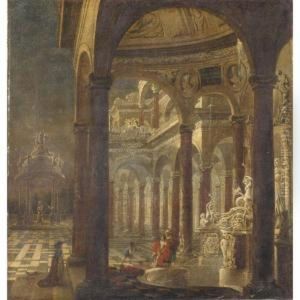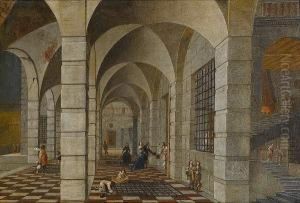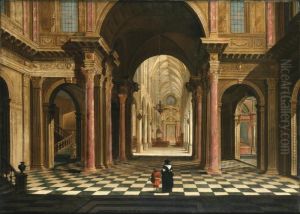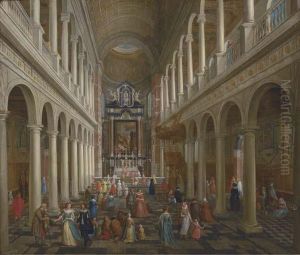Wilhelm Schubert Von Ehrenberg Paintings
Wilhelm Schubert von Ehrenberg was a Flemish painter who specialized in architectural paintings, predominantly depicting church interiors and palaces filled with numerous figures. He was born in 1630 in Germany but spent much of his professional life in the Southern Netherlands, which is present-day Belgium. Von Ehrenberg's work is characterized by its meticulous attention to detail, perspective, and use of light.
Not much is known about von Ehrenberg's early life and training. However, it is believed that he became a master in the Antwerp Guild of Saint Luke in 1654, indicating that he had completed his training by that time. His work was influenced by earlier Flemish and Dutch painters who specialized in similar subject matter, such as Hendrik van Steenwijk II and Dirk van Delen.
Von Ehrenberg's paintings often depict the grandeur of baroque architecture, with its ornate decorations and dramatic use of light and shadow. He was skilled at rendering the interiors of churches, capturing the intricate details of the altarpieces, vaulted ceilings, and columns. His works were composed with a sense of depth and perspective that drew the viewer into the scene. Additionally, he frequently included small human figures in his compositions, which provided a sense of scale and liveliness to the grand architectural settings.
During his lifetime, Wilhelm Schubert von Ehrenberg collaborated with other artists. It was not uncommon for painters of that era to specialize in particular subjects. For example, von Ehrenberg would paint the architectural elements while figures would be painted by artists such as David Teniers the Younger and other contemporaries.
Wilhelm Schubert von Ehrenberg's contribution to the genre of architectural painting was significant, and his works can be found in various museums and collections across Europe. Despite the fact that he is not as well-known as some of his contemporaries, his paintings are valued for their technical skill and historical depiction of baroque interiors. He died in Antwerp in 1676, leaving behind a body of work that continues to be studied and appreciated for its artistic merit and historical value.



